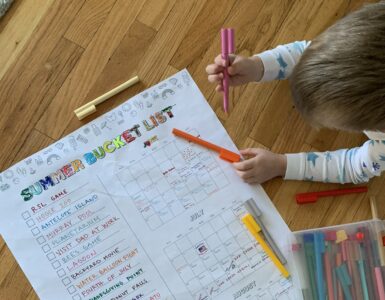Want to raise financially savvy kids? Set up a family bank and let kids earn their own money and buy their own stuff.
Authors, Richard and Linda Eyre say opening a family bank can rescue kids from the entitlement trap and teach practical, real life money lessons.
Establishing the Family Economy
The system described here works best when it is started with 7-12 year olds, and we think 8 is the ideal beginning age. (In fact, we suggest that if you have kids under 8, you inaugurate it with them starting on their eighth birthday.) Having said that, the “economy” works well with kids up to at least 15, though your methods of explaining and implementing it may have to be adjusted for teens.
The basic thesis of the idea is that if kids are given a legitimate and fair way to earn money, they will develop initiative and motivation because they perceive ownership. If they have a chance to budget and spend that money they will learn discernment and discipline. If they save and invest their money they will understand delayed gratification. And in the process, both their gratitude and generosity will have a climate in which to grow.
The basic process of the idea is to take the money you are already spending on your kids and re-route it through their ownership and choices, and to make the whole process part of a natural economy where parts of the money that comes into a household goes out to those who do parts of the common work of the household.
The basic premise of the idea is that it is better to have children learning the lessons of earning and spending and saving (and making mistakes in all three) while they are young and the stakes are small than when they are older and the stakes are large (and when banks start sending them pre approved credit cards.)
The basic props of the idea are a family bank (a big wooden box, maybe painted silver or gold, with a big padlock on it and a slot in the top), a checkbook for each participating child (a real checkbook with the child’s name imprinted and with a check register—get them from a bank—open an account and close it if you have to), and a basic peg board with four pegs for each child (the bigger the better, and the pegs better be tied or chained on, or they will get lost.)
Keep in mind now, as we discuss the details of implementation that the system is not just about money; it is about responsibility and initiative and self-motivation–and money is the vehicle or the raw material that is used in the process.
Implementation
Don’t be in a rush to implement everything all at once. Take it a step at a time, and make it a thorough process involving a lot of discussion and questions and answers. Use the outline below as a guide, but alter the system and the idea to fit your family and your kids. If it takes a few weeks to get to full implementation, that is fine. Better to have it fully understood than to dive it without adequate preparation. Here is the sequence:
First: Announce to the child that you believe he is now old enough to become part of the family economy. This will mean that he will be able to have much more money than he has previously had, but he will be expected to earn it, and he will then be responsible for buying the things he wants rather than asking you for them. He will have an account in the Family Bank, and will have his own checkbook so that he can take money out of the bank by writing a check and put money in with a deposit slip. Show him how the checkbook has a check register so he can always keep track of how much money he has. (Have $50 in the account and already written at the top of the check register.) Tell him you are very proud of him and excited for him to have a checkbook and a bank account just like you.
Second: Explain that there is a certain amount of money that comes into the household, and there are certain things that need to be done to keep the household going and in good shape. Make a list of all the jobs, tasks, and maintenance that are required. Include specific things like cleaning each room, fixing each meal, mowing the lawn, doing the wash. Also include things like getting kids ready for school or bed, making sure the homework and music practice gets done, getting everyone ready for bed. Ask if it makes sense that those who participate in the work in the household should get part of the money that comes into the household.
Third: Ask how the child thinks he can get more money into his bank account and into his checkbook. Explain that you have decided that he is old enough to have responsibility for some of the things that have to be done in the household, and that if he can remember to do them, he will get paid on “payday” which will be each Saturday. Introduce the pegboard (which should have his name on it) and explain that there are four pegs he can get each weekday, and that each of them will go toward the amount he earns for the week. The first peg is the “morning peg” and can be put in when he gets up on time, gets ready for school, has breakfast and has everything together to leave for school on time. He can put the second “homework peg” in after school when he has finished his homework and his music practice. The third “zone peg” can go in when he has checked on and cleaned up his zone. (Each child should have one small “common area” of the house—a hallway or closet or front porch—that everyone uses. This should be an area that you don’t clean—that is left for the child.) And the fourth “bedtime peg” goes in if he is in bed by bedtime; teeth brushed, prayer said, school stuff laid out for the next day.
Fourth: Explain that before bed each weeknight, the child can get a “slip” (small cards or post-it notes work fine) and write a “1”, “2”, “3” or “4” on it, depending on how many of the pegs he got in that day. The slip must then be initialed by a parent (or by the tender if the parents are out) and can then be put through the slot into the family bank. On Saturday it is payday, and the bank is opened by the banker (we usually suggest dad) and each child gets his slips and adds up his total. How much “pay” he gets is according to how many pegs he got in during the week.
Pay does not come in cash, but by a debit entry in the child’s check register, initialed by the banker. The child can then take out as much as he wants by writing a check (or he can bring along his checkbook when he goes shopping with a parent, and write out checks for what he wants, always being sure to deduct it in his check register before writing the check.) The check goes to the parent, who then pays for what the child bought.
Cautions
A few things to watch out for:
1. What you don’t want is to create a disproportionate focus on money or to make your kids into little mercenaries who respond to every request with “how much will you pay me for that?” Be careful to make it clear to the child that the family economy applies only to a limited number of things. It is just a little family economy to help share some of the tasks and to help kids have their own money to buy their own things. Be sure they understand that “getting paid” does not apply to things outside of what is represented on their economy pegboard and that they should never ask to get paid for other things that you ask them to do, or for keeping their own room nice, or for doing other things that they are supposed to do.
Explain also that there are bigger, more important reasons than money for doing the things on the pegboard too. We do our homework so we can learn. We get ready for school so mom doesn’t have to bug us and so we don’t miss the bus. We take care of our zone because we all share our house. The money is just a little bonus, and only for the things in the economy, and the reason we have it is to help us to each be able to earn our own money.
2. Don’t do too much reminding. The whole idea is to have a system that polices and motivates itself. Adopt a matter-of-fact attitude that essentially conveys that “if you remember to do the things, and put in your pegs, and get your slip signed each night, fine, you will get paid for them. If you don’t, you won’t, because that’s how economies work.”
Kids will gradually (some faster than others) develop their own motivation if you just let the system work. Some will feel the need for money (or more money) very quickly, because they are concerned about clothes, or because they already have things they want to buy. Others will get motivated later when something comes along that they really want. Still others will be motivated just by the system itself and their desire to do well and to please you.
3. Don’t “rescue” them all the time, or bail them out. The hardest thing is to let the system work. If they spend all their money on Saturday and don’t have anything left when they want to go to a movie with their friends, just say you are sorry, that you have made the same kind of mistake yourself, and hope they do better budgeting next week. If they spend their money on a too-expensive name brand, let them figure it out themselves. If they ask for a loan, tell them it’s not that kind of bank.
Really letting the economy unfold and develop is the key, and not expecting some kind of magical quick fix. Biting your tongue and letting them make decisions is hard, but remember that the whole idea is to learn from mistakes made now while the stakes are small. Give a little advice now and then, especially if they ask for it, but remind them that it is their money and their decision. (This does not mean, of course, that you can’t have rules about things they cannot buy.)
4. Give your attention for the positive behavior, and ignore or pay as little attention as possible to the poor performance. If you have two kids, and one gets 19 of his 20 pegs that week, and the other gets 3, what you don’t want to do is focus on the second kid and say something like “When are you going to get it. Look how much your brother got. What’s the problem?” Instead, ignore the underachiever and focus on the go-getter: “Wow, 19 of 20! How did you remember every day? Do you have a system? I don’t remember reminding you once! Way to go!”
Remember that this family economy is a reward and incentive system, not a punishment or penalty system. The downside should simply be the absence of the reward and of the praise and attention that goes with doing well.
5. Don’t pay too much, but offer the potential for substantially more than the old allowance. Remember that the deal is for them to assume the responsibility not only for earning but for spending, and that they need enough to buy a large percentage of the stuff that you were buying for them before. Try to calculate roughly what you have been spending on your child in an average week, and set up the economy so that, if he gets all or most of his pegs, he can earn most of that.
Realistically, there will always be things he won’t want to buy for himself (underwear for example) and you will end up continuing to buy some things for him, but if you set it up right, your child should be able to begin deciding on more and more things himself, and paying for them.
The Eyre’s new book THE ENTITLEMENT TRAP is now available for preorder. Just go to www.valuesparenting.com and click on the book cover.
New York Times #1 Bestselling Authors Richard and Linda Eyre are the parents of nine children and, by coincidence, the authors of 9 internationally distributed parenting and life-balance books. They lecture throughout the world on family related topics, and are the founders of Joyschools.com. Visit the Eyres anytime at www.TheEyres.com or www.valuesparenting.com















Add comment